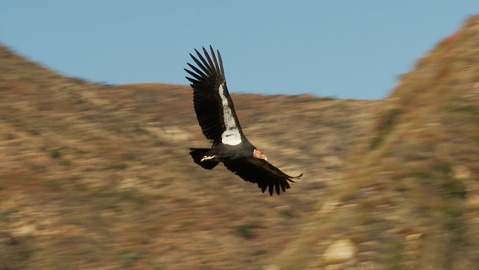The Condor’s Shadow
Director Jeff McLoughlin

For a peek into our big backyard, The Condor’s Shadow dissects the valiant efforts being made to protect the critically endangered California Condor, as well as the manmade threats that continue to thwart conservationists’ work. Below, we chat with director Jeff McLoughlin about the inspiration behind his new environmentally minded documentary.
What inspired you to become a filmmaker?
Photography is something that’s been a part of my life since high school. I was inspired by the Jacques Cousteau ocean wildlife films as a youth and went on to study film theory and production at San Francisco State University. After college I returned to Santa Barbara to pursue business opportunities and I deferred on my aspirations to be a filmmaker. Later in life the opportunity came up to produce corporate video and, by that point, digital video production made independent filmmaking more viable.
I worked with a number of talented people including local filmmaker Ethan Turpin and along the way developed the skill set to direct and produce. Professionally, I’ve produced dozens of corporate films and last year’s SBIFF entry, The Non-Lead Hunter with Anthony Prieto. The Condor’s Shadow is my first feature length documentary.
What’s the basic concept behind your film?
The Condor’s Shadow is an environmental documentary on the recovery of the California condor. It is a wildlife film, but at its heart it’s a story about the passion it takes to pull a species back from the brink of extinction. Reduced to a population of just 22 birds by 1982, the species has been restored to over 400 today.
The narrative of the film follows Ventura-based biologist Joseph Brandt on a quest to establish a successful wild nest for a pair of condors in the wild. The extreme lengths that Joseph and the others in the recovery effort go to in pursuit of this goal make this an interesting and emotionally engaging film.
What led you to create this film?
I was inspired by a story on the condor program in The Santa Barbara Independent by Matt Kettmann. Matt is a gifted writer and captured the nuance as well as the dilemma of the endangered species recovery program. I knew after reading his work that this was a story worth telling on film.
Does the film have an entry point that hooks the viewer?
We get up close and personal with a bird named Pitahsi (a Chumash name meaning “the power within”) and come to understand the broad reach humans have into the remote corners of the backcountry. The interactions that biologist Joseph Brandt has with this condor are probably the most compelling scenes in the film.
During the process of creating this film, what did you learn or experience that was most surprising?
Condors approached extinction due to exposure to lead that they ingest while scavenging on the remains of hunter-shot game. It’s an ongoing dilemma for the condor recovery effort and the film examines this in the context of the wildlife story.
What do you hope viewers come away with after watching the film?
Not many would ever have imagined that spent lead ammunition in hunter-shot game would harm a beautiful soaring bird. But it does and with just a few small changes we can fix that. I hope people will mention this to their friends who hunt and those who manage nuisance animals on ranch lands.
Hunting actually provides a great food source to condors and other scavengers. A simple change from a lead bullet to a copper one would mean one less toxic substance cast out onto the earth by humans. Yes, it will cost a few extra dollars, but I think most would agree that watching a bird with a 10-foot wingspan soar over your head is worth every penny.
What’s your Santa Barbara connection
I’ve lived in Santa Barbara since 1969, attended Santa Barbara High, built a successful business, and raised two children here with my wife, Kristi.
How does living in Santa Barbara support you as a filmmaker?
There is a robust community of writers, filmmakers, and post-production talent here in Santa Barbara that I’ve found very supportive. Matt Kettmann helped out with editing and rewriting my long-winded narration for the film. Local filmmakers Ethan Turpin, Donnie Hedden, and Ky Shultz, a Brooks Institute grad, shot significant segments in The Condor’s Shadow. It’s a great place to be creative and what I can’t source here in terms of post-production is just a 90-minute drive away.
Does your film capture some aspect today’s cultural gestalt or zeitgeist? In what way?
I think we have entered a phase in human history where most acknowledge that our impacts on the earth have many unintended consequences. The larger message of the film is in seeing that we can make an impact as individuals. With commitment we can leave the world a slightly better place than when we entered it both for the environment and for humanity.
The Condor’s Shadow screens on Wed., Jan. 30, 1:20 p.m., at the Metro 4 and on Sat., Feb. 2, 10 a.m., at the Santa Barbara Museum of Art.



